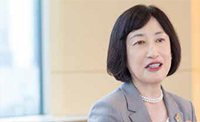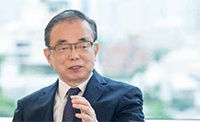Corporate Governance
Latest Update : Oct.16, 2024
Back to Roundtable Discussions with Outside Directors
Outside Directors in Roundtable Discussion
Sustainable Management at MinebeaMitsumi Looking Back, Looking Forward
We took the opportunity to discuss MinebeaMitsumi's sustainable management and corporate governance with existing Outside Directors Kohshi Murakami and Atsuko Matsumura, and newly appointed Outside Director Yuko Haga.
 |
|
My highest priority is to maintain my objectivity from an independent viewpoint |
|
Outside Director |
 |
|
Our strategy of building a portfolio of businesses with an eye on the long term bore fruit during the coronavirus crisis |
|
Outside Director |
 |
|
It is important for the Nomination Committee to implement proper management of the succession plan |
|
Outside Director |
As an Outside Director, what are your views on the growth of the Company up to this point, and on the leadership of the President?
Murakami: I believe that the driving forces behind the threefold increase in net sales and the fivefold increase in operating income over the past ten years are the superb management skills of the President, his powerful leadership, and the fact that the corporate philosophy, "to contribute to society by `Producing better products, with faster speed, in larger numbers, at lower cost and by smarter means'" has been instilled in all employees. With a short-termist approach to management the focus is put only on profitable businesses, and the unprofitable areas tend to get squeezed out-but that is not the case with this company, which has built a portfolio of businesses with an eye on the long term, and which I think is linked to the way it maintained its performance despite the recent coronavirus crisis.
Matsumura: My feeling is that the President has supported the sustainable growth of the Company through the strength of his belief in various difficult times, and the speed with which he reacts to situations. The President conveys his vision to all employees through a regular publication called "Navigation," which explains the current situation of the Company and gives a sense of reassurance and motivation to employees. In addition, at meetings held twice a year for nearly a week (Top Meeting and business plan review meeting), the thoughts of the President are conveyed to the heads of each department, and in this way the organization of this large group is unified. Moreover, the President proposes a variety of initiatives based on his own unique ideas. For example, he is promoting plans for teambuilding from the perspective of utilizing human resources. Employees react to the President's enthusiasm, for example by coming up with effective ideas of their own, and I think this interaction between the President and staff is one of the strengths of the Company.
Haga: My research themes are M&A and management strategy, so I have seen a variety of cases over the years. My understanding is that there are almost no companies that have managed to implement such a number of mergers and acquisitions while also continuing to grow organically. I was impressed by the President's responses to questions put to him at my first meeting of the Board of Directors in June. Rather than simply responding to the questions related to the issue at hand, he gave a solid explanation of his positions from a future-oriented perspective. It gave me a sense of the abilities that have allowed him to drive growth while conducting M&A over a span of many years, and of the strength of the leadership that supports it.
As someone who has repeatedly succeeded as an M&A expert, the President often uses phrases like "on-site strength" and "discernment." How do you feel about this?
Matsumura: With regard to the growth of the Company through M&A, I would point to two factors. The first is that we prepare meticulously for integration, and we consider synergies very carefully. The second is the way that the President communicates with all the employees in the newly integrated company directly after the integration has taken place. In addition to discussing the post-integration positioning of the new business within the organization of the Company, these communications include details on the utilization of human resources after integration, which is conducted in a spirit of equality. We believe that this ability to communicate inspires the employees of the other company, and helps enhance synergistic effects.
Haga: I think the reason for the President's success in so many M&A transactions is that he forms a clear idea of the objective of the acquisition beforehand, as well as having a well-defined vision for after the purchase has been completed. I imagine that he is careful to use negotiation and due diligence to ascertain whether those objectives can be achieved or not. What is important in M&A-driven growth is not whether the company succeeds in coming to an agreement and acquiring another, but to what degree the combining of the acquired management resources with the company's own resources results in the expected synergies being achieved. From the perspective of portfolio management, another important factor is the ability to make appropriate decisions with regard to businesses for which there is no rationale for continuing to hold, even if the operations are profitable. At the PMI stage, I would expect the extent to which the synergy effects originally envisaged are achieved to be verified by setting KPIs that are checked at regular intervals.
Murakami: As both of you have pointed out, PMI is also important. In addition, the President places great importance on personal relationships and trust relationships on the side being acquired. Many times we have heard comments such as "If we're going to be acquired anyway, we'd like to be acquired by Minebea." Even after the acquisition, he takes good care of the acquired company, and I think it's fair to say that the ability to cultivate these trust relationships is also a factor in our success. In addition, the President's background is the relative approach taken by lawyers and attorneys, and rather than listening to just one side, he also pays attention to the opinions of outside officers, and acknowledges their arguments. Previously we Outside Directors have seen a number of projects that we thought were problematic, and that were canceled as a result of discussions; or project decisions that, after questioning by Directors, were postponed by the President until the next time to allow time for consideration. Nevertheless, if after such discussions we encounter a project that we think should go forward, even if it entails assuming a certain amount of risk, as Outside Directors, we have taken the approach of providing encouragement to the President as board members.
It is because the President has properly responded to this encouragement that the Company has grown into what it is today, in my opinion.
Our next topic is the Board of Directors. We would like to hear your views on what areas could be enhanced and on how it could evolve going forward, including themes such as sustainability.
Matsumura: I see discussions by the Board of Directors to promote sustainability as being an important part of improving corporate value when pursuing challenging targets. The Company has identified material issues (Materiality) in relation to the promotion of sustainability and set priority topics by category, such as creating workplaces that maximize the abilities of employees, contributing in various ways to society, and ensuring stable supplies of precision products that support society. In relation to these topics, which have not previously been fully discussed at meetings of the Board of Directors due to time constraints, I think we need an opportunity to discuss specific initiatives to address them and the methods by which we develop them. As an example, I would point to our unique and highly efficient global system for human resources development, which includes the full utilization of female talent. With regard to the use of female talent, I myself traveled to factories in Karuizawa, Hamamatsu and Fujisawa at the beginning of the year to speak with female employees. I was able to confirm that various opportunities are provided to women looking to advance their career, and that various routes to managerial roles are open to them. I hope that the existence of such role models will lead to more extensive use of women's abilities within the Company going forward. On the other hand, I also feel it is important to discuss the Company's support structure for achieving a balance between work and child rearing, caring for family members, etc.
Haga: At the Board meetings there is a trade-off between the number of items on the agenda and the amount of time for discussion, so I think achieving a balance there is important.
I also feel that one valuable function of the Board of Directors is not just to say whether it is "for" or "against" a project, but to discuss the logic leading up to those decisions, and the thinking behind them. Using the example of material issues mentioned by Ms. Matsumura, I think that information can be provided right from the investigative stage, such as by holding interviews to ask Outside Directors which viewpoint we should take into account, then based on that, we can work to deepen discussions at meetings of the Board of Directors. I would also like the Company to consider how to create time for discussions by streamlining the number of agenda items.
What about mutual communication with Internal Directors, and the sharing of information with Outside Directors?
Matsumura: Partly because one of our goals is to deepen discussions at the Board of Directors, new opportunities for Outside Directors to have regular face-to-face meetings with the President have been established. In cases where we get information directly from the President, we will be sure to use it effectively. In addition, liaison councils between the Audit & Supervisory Board Members and Outside Directors have also become more energized, and the amount of information offered at such meetings has increased. I feel that the cooperation between Audit & Supervisory Board Members and Outside Directors is becoming stronger. This can be seen in the way that points made during discussion at meetings of the Board of Directors which need to be followed up are deliberated in more depth at the liaison councils immediately following the Board meetings.
Haga: This is partly an aspiration for the future, but Outside Directors want to fully understand in advance the agenda items presented at meetings of the Board of Directors, so at the very least it would be good to be able to secure time for that.
With regard to providing explanations beforehand, I think it should be possible to go through the Secretariat to ask for explanations directly from the department that is tabling the agenda item. Beginning this fiscal year, there has been one additional independent Outside Director, so that independent Outside Directors account for one third of the Board of Directors. This has resulted in a further strengthening of the governance structure. This will probably require some consideration of the number of people working in the Secretariat that supports the Board of Directors, and of the structure of the Secretariat.
Murakami: Rather than being constrained by previous practice, we should exchange opinions throughout the Company regarding what is needed for more substantial discussions at the Board of Directors, while moving forward with mutual cooperation between Outside Directors.
Finally, the Nomination and Compensation Committee that was set up as an advisory body to the Board of Directors is now in its second year. How do you view its prospects going forward?
Murakami: The Company's voluntary Nomination and Compensation Committee will utilize the freedom it was designed to have. As mentioned by Ms. Haga just now, its structure strengthens the involvement of independent outside officers, and its members include one Outside Audit & Supervisory Board Member. As a Committee, it is involved in the decision-making process for nominating and compensating Directors and I believe that its opinions have carried considerable weight in compensation-related matters. There is room for debate on whether the compensation of Directors should include an indicator representing corporate value over the medium to long term, or whether greater weight should be given to the contribution of recent performance, but I think this is an area where trial and error will continue to be required going forward. I believe that deliberating matters at the Nomination and Compensation Committee has led to greater objectivity, transparency and fairness, and it seems to me that Directors are also convinced that this is the case.
Matsumura: Under the leadership of Mr. Murakami, who chairs the Nomination and Compensation Committee, we have dealt with a considerable volume of compensation-related matters over the nine meetings of the Committee that have been held since it was established. Moreover, this time we introduced a new share granting trust system. The compensation system for Directors consists of a mechanism whereby shares of the Company are granted in accordance with the degree of achievement towards the Company's performance, and the level of individual contribution. The Committee has conducted discussions from a variety of viewpoints, and we expect to see results from incentives aimed at improving the performance of officers, and further increasing their contribution to the Company. In terms of nominations, we conducted interviews with candidates in relation to the most important personnel matters, and we were also given opportunities to receive appropriate training in relation to succession plans. Through training such as this, I came to feel the necessity of recognizing the various possibilities in relation to succession plans. In addition, I feel it is important to implement appropriate monitoring of the optimal planning for the Company.
Haga: I consider that my experience in giving advice related to management is the reason why I was asked to be newly appointed as an Outside Director. The composition of the current Board of Directors is such that when viewed in terms of a skills matrix, there are outside officers from a really wide range of fields, and this suggests that monitoring and the provision of advice can be implemented from a variety of angles and perspectives.
As a member of the Nomination and Compensation Committee, I think it is important to consider our objective to be not the nomination itself, but rather the proper management of the succession plan. This is a point that is often misunderstood by the outside world, but the Nomination and Compensation Committee does not create the succession plan. Instead it periodically monitors whether the actions taken by the personnel and human resources development departments are following appropriate processes and methods. Interviews with the candidate are a way of confirming their reasonableness, and I believe that this should be the role taken by the Nomination Committee with regard to succession planning. What is difficult in the case of the Company is not that it is an organization that has grown to be large through a single business, but that due to the integration of businesses we have many companies all working together. Rather than only having a plan for nurturing new graduates, I believe we must consider how to provide equal opportunities to those people who have joined us through integrations, and if we are still unable to acquire the human resources we need, we must look at hiring from outside the Company.
Murakami: I agree. With regard to the nomination of officers, we have begun interviews and so on with the Executive Officer class that provides the candidates. And in addition to nominating candidates for officers, we must also consider how to set up an appropriately functioning compensation system of incentives for officers.
Haga: This performance-linked stock compensation system is just the sort of thing that aligns interests with those of shareholders, and I feel it is the kind of system that will be well received even from the perspective of investors. How much of an incentive this provides to Directors is something that we must verify going forward. With regard to the weightings assigned to the evaluation of individual contributions and the evaluation of the Company's results respectively, I think it should also be possible to change this proportion somewhat, depending on the role of the officer and their experience. Compensation for officers will vary according to their position. Depending on the role taken by the officer, I think we must consider what percentage of total compensation is fixed, and what percentage is performance-linked.
Murakami: When we talk about incentives for Directors, we do not mean the next one to two years. The issue is more about taking into account medium- to long-term factors. We have introduced a performance-linked stock compensation system, but we must continue to focus on this to ascertain whether the overall compensation structure provides appropriate incentives to Directors.











